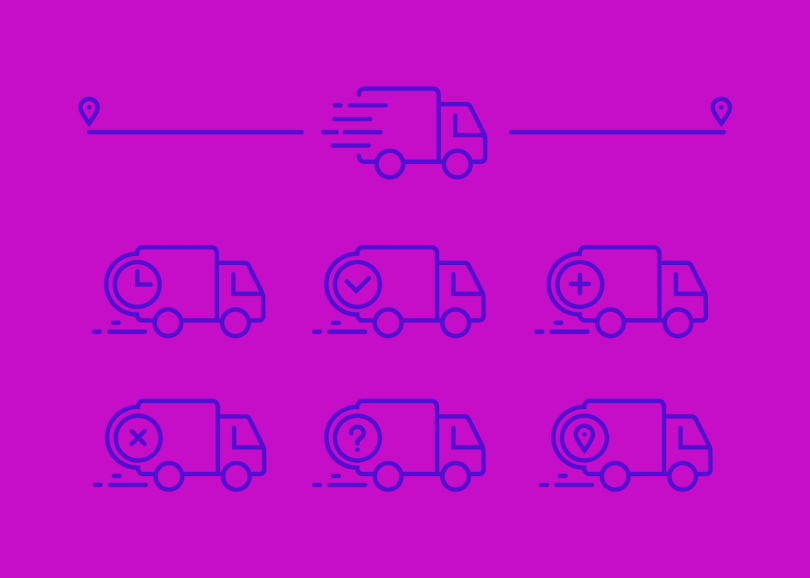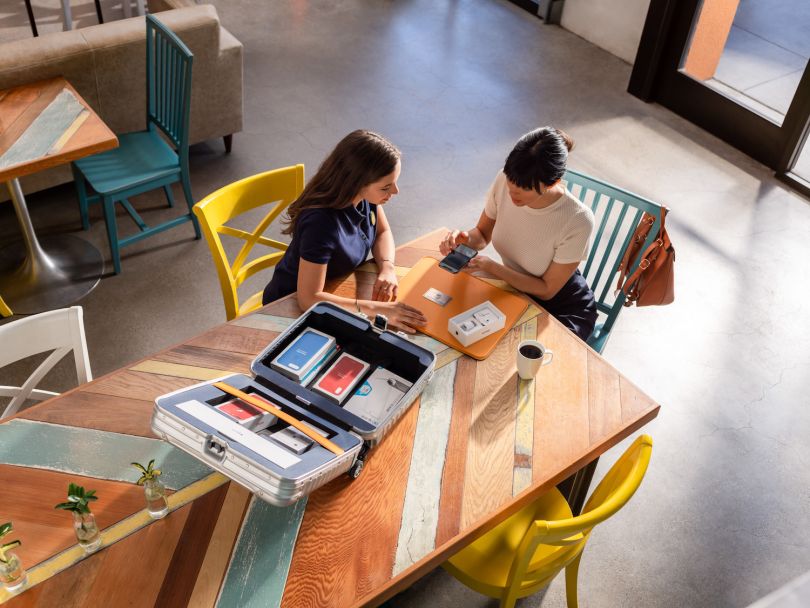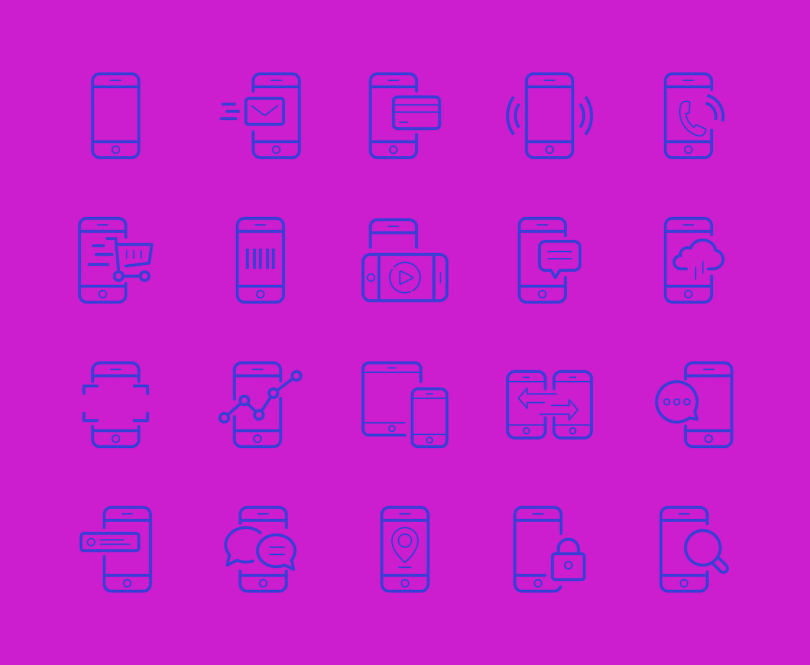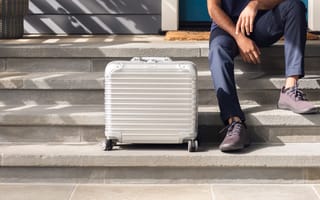What if the best parts of the Apple Store — its inventory, its service, its sheen — could come to you? That’s the question Ron Johnson, the former VP of retail at Apple, posed to Tom Suiter and his son Scott eight years ago when pitching them the idea for Enjoy, a mobile retail store that delivers technology to people’s homes and helps them get it set up and configured.
The Suiters, who then operated a Bay Area brand agency, knew Johnson well. Tom Suiter was Apple’s first creative director. He had witnessed Johnson — a retail marvel, who, in addition to his tenure at Apple, had also served as vice president of merchandising at Target and CEO at JC Penney — devise the concept for the Apple Store and lead its development for more than a decade. Throughout the meeting, Johnson kept repeating the phrase, “What if you could order today and enjoy tomorrow?”
“He must have said it over 20 times,” Scott Suiter said. “So we called it Enjoy.”
“We truly believe people deserve more than just a brown box on their doorstep.”
The more the Suiters used the code name, the more they liked it. So they went back to Johnson with a pitch deck focused on the name and a “smart last mile” order fulfillment service that combined speed and high-touch service. Think Amazon Prime meets the Geek Squad.
Essentially, you order something online — say, a new iPhone from AT&T — and, usually no later than the next day, an associate arrives at your door with a suitcase full of merchandise.
These associates, called “experts,” are trained to get the technology working, connected to other devices and configured to your preferences. They drive cargo vans stocked with boxes of gear and organize their days through an AI-powered employee app that tracks their locations and connects with an order-fulfillment system. They are the trusted stewards of sub-warehouses on wheels.
Apple Stores have done well historically, Suiter said, but customers have to travel to them and, in recent years, they’ve become congested. Amazon is known for its delivery speed, but it offers little in the way of customer support. Enjoy aims to thread that needle, working backstage for high-volume broadband carriers — like AT&T in the United States, Rogers in Canada and BT and EE in the United Kingdom — to give these companies an edge over their competition by ensuring people are satisfied with their tech products and can get them up and running.
Enjoy plans to hire 1,000 new employees by year’s end and was recently honored with a Fast Company Design Award for its smart last-mile system. Here are the strategies the company is employing to win customer approval early in the product journey and reimagine the end-to-end online shopping experience.

API-Tracked Inventory Moves According to Demand
Capturing customers as they enter the purchase funnel is key to the service model. Enjoy is embedded in the order-fulfillment processes of its partners in three ways: through recommendations made on customer support calls, referrals from associates at retail stores where inventory is low and, most commonly, via APIs integrated with partners’ checkout pages.
When customers add products to their carts, they have the option to add a free delivery and service option. This looks different from company to company. For AT&T, it is branded as “Right to You.” Rogers calls it “Pro On-the-Go.” Enjoy might be mentioned as a delivery partner, but the upper funnel messaging is branded by the client.
On the road throughout the day, Enjoy’s vehicles are stocked with products, so orders can be fulfilled on the fly. Similar to how ride-hailing services use GPS location data to direct drivers to nearby riders, Enjoy tracks available inventory in relation to customers’ locations.
“We’re cutting the replenishment station out and actually having that be in the vehicle.”
“Let’s just say Jen is an expert, and she’s driving around. Our APIs know what inventory is in the back of her car, where she is and if she’s eligible to deliver the device that’s being ordered by you, who happen to be sort of in that same ZIP code,” Suiter said.
That level of software integration means orders can be delivered quickly — sometimes in as little as seven minutes — in high-density metropolitan areas like Manhattan.
“If you think about a lot of other delivery models right now: Instacart has got to go to [the grocery store], and then to the customer’s house. We’re cutting that replenishment station out and actually having that be in the vehicle,” Suiter said.

Differentiating by Something Other Than Price
Not surprisingly, throughout 2020 online sales in the U.S. have continued to grow as a percentage of total retail sales. The U.S. Census Bureau reports that, as of the second quarter of 2020, e-commerce sales represented 16 percent of total retail sales, a 31 percent increase from the first quarter and a 44.5 percent increase from the same quarter in 2019.
But while online fulfillment represents a growing retail channel that is often lower in price than a comparable brick-and-mortar experience, it lags behind in-store shopping when measured by net promoter score (NPS), a customer satisfaction metric calculated by a formula evaluating survey responses to the question, “How likely are you to recommend this product to a friend?”
Survey responses are tallied on a 10-point scale. The percentage of people likely to promote your product (those who answer the question above with a nine or 10) minus the percentage of people likely to belittle it (those who give it a six or below) yields the result.
Hubspot.com reports that the average NPS is 43 for online shopping versus 52 for department and specialty stores. Enjoy’s internally reported score of 89 suggests its model is leading to happier customers than either a traditional retail store or e-commerce experience.
“If you think about the carrier space, it’s pretty cutthroat. It’s sort of like, what can you provide that the other guys can’t? So this high-touch, hand-delivery store set-up is truly unique,” Suiter said. “That’s why AT&T’s on board.”
To build brand loyalty at the onboarding stage, when the risk of churn is especially high, Enjoy includes delivery, activation, set-up, trade-ins, shopping and demos as part of the standard service experience. An expert might perform a back-end SIM swap, talk through a carrier’s coverage plans to help a customer get a better deal — or help people activate features they aren’t sure how to install or don’t know exist.
Suiter recently bought his 70-year-old aunt an Apple Watch for her birthday. An Enjoy expert helped her turn on the fall detection feature, and set it up to notify her emergency contacts should the watch’s sensors detect a dangerous fall pattern. This kind of personalized support is customary. Prior to a visit, as part of a discovery phase, experts typically call customers to gauge their needs and interests and plan the visit accordingly.
“Everybody loves unboxing an iPhone for the first time. And so we’ve sort of found being at the beginning of the experience is ideal.”
“You know, why did you buy that watch? What do you want it to do when you get it?” Suiter said. “They might find out, ‘Hey, you’re really into triathlon training and photography.’ And so the expert goes into the delivery, knowing, ‘Hey, I really want to demo this cool Strava app and then show you the remote shutter on the camera feature.’”
Experts are technicians but also sales professionals. Arriving at a customer’s door bearing a silver briefcase full of merchandise, they show up when customers tend to be happiest and open to shopping for accessories, the giddy moment Suiter refers to as “unboxing.” While the service is free to consumers, Enjoy receives a flat fee from their clients, plus a percentage share of any enhanced features or upgrades.
“Everybody loves unboxing an iPhone for the first time. And so we’ve sort of found being at the beginning of the experience is ideal,” he said. “We tried break-fix for a little while. And it’s hard. We found that customers tend to be coming more from a place of despair and anger that their product is broken. To repair that relationship can often be very difficult — but also out of your hands.”
Best Buy’s Geek Squad does a fine job fixing broken devices or connections, he said, which is why it is one of the few options for in-home tech service. But Enjoy’s strategy takes a different tack. It’s directed at the onboarding experience, where the interaction is likely to be warmer and more convivial.
You’ve just unwrapped your new toy. Now what can it do?

Proprietary Technology Provides a Competitive Edge
Enjoy’s service model rests on the bulwark of proprietary software designed to pose a barrier to others seeking to enter the market. Their tool suite includes an expert app, inventory management system, performance manager and live scheduler.
The expert app allows employees to choose their work schedules (typically four 10-hour shifts), submit their hours, manage their daily schedules and read a company newsletter. It is populated with customer information and can scan bar codes and International Mobile Equipment Identity codes to track inventory. By shaking the phone while the app is active, an expert can submit a feature or bug request.
“We’ve created a fun kind of network effect as well, where these experts can compete with people in [different cities],” Suiter said. “And they’re getting to know each other. They’re seeing, like, ‘Oh, that expert is doing really well, how do they do it? How do I reach out to them and understand their best practices?’”
Because Enjoy’s software tools share the same library of assets and are updated in real time, managers, known as captains, can re-assign visits based on available inventory. This is not an entirely new idea. Companies like Oracle have devised sophisticated inventory management systems that can be used to perform similar functions. The difference is few, if any, of these systems are designed to track products on a moving, real-time geographic scale. This is where Enjoy believes it has a market advantage over other online retailers.
“What we’ve done is built tools where we can, geographically, see where [experts] are,” Suiter said. “We can see that they’re meeting with the customer, we can see that they’ve been on a visit for a little longer than expected. And we have ways to send a message to the expert, and say, ‘Hey, is everything going OK?’”
Perhaps the most intriguing aspect of the platform is how it leverages artificial intelligence to detect location-specific buying habits and use this data to expedite delivery. “The systems know, ‘Hey, this ZIP code tends to buy this iPhone SKU more regularly. And so [we] start to put that type of inventory in the vehicle. Then, [the system] starts to become a lot smarter,” Suiter said.
And, presumably, by moving inventory closer to the consumers who want it, sellers can move faster.
Enjoy Sells to Retailers, Not Consumers
But how fast? If speed has become table stakes for consumers to buy online, as Suiter claims, how does Enjoy stack up to Amazon, a company with a fleet of drones and options for same-day — even two-hour — delivery. Enjoy is fast. But is it Amazon fast?
Suiter told me they’ve never done a head-to-head race, but most Enjoy deliveries are done on the same day or the next day. In other words, it’s in the same league. And its aim is to continue to improve delivery speed until consumers can reliably receive a product faster than they would if they drove to purchase it from a nearby retailer.
“We’ve all seen the photos of the Amazon guy kicking the box over the fence or dropping the TV.”
Ultimately, Enjoy may be competing for a different piece of the pie than its rivals. Its core customers are telecommunication companies seeking a high-quality customer experience for products consumers buy once or twice a year — not every few weeks. But that doesn’t mean they don’t recognize the Achilles’ heel of their competition.
“[Amazon’s] logistics and their last mile is crazy,” Suiter said. “You know, they’ve got their own airline, they built out their own electric car fleet. It’s truly astounding, and I think they’re definitely sort of the Goliath.”
He continued: “But we’ve all seen the photos of the Amazon guy kicking the box over the fence or dropping the TV. They are very good at handling household items. But would all brands entrust that sort of retail experience to a third party? Probably not.”




